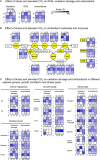Future Climate CO2 Levels Mitigate Stress Impact on Plants: Increased Defense or Decreased Challenge?
- PMID: 27200030
- PMCID: PMC4852726
- DOI: 10.3389/fpls.2016.00556
Future Climate CO2 Levels Mitigate Stress Impact on Plants: Increased Defense or Decreased Challenge?
Abstract
Elevated atmospheric CO2 can stimulate plant growth by providing additional C (fertilization effect), and is observed to mitigate abiotic stress impact. Although, the mechanisms underlying the stress mitigating effect are not yet clear, increased antioxidant defenses, have been held primarily responsible (antioxidant hypothesis). A systematic literature analysis, including "all" papers [Web of Science (WoS)-cited], addressing elevated CO2 effects on abiotic stress responses and antioxidants (105 papers), confirms the frequent occurrence of the stress mitigation effect. However, it also demonstrates that, in stress conditions, elevated CO2 is reported to increase antioxidants, only in about 22% of the observations (e.g., for polyphenols, peroxidases, superoxide dismutase, monodehydroascorbate reductase). In most observations, under stress and elevated CO2 the levels of key antioxidants and antioxidant enzymes are reported to remain unchanged (50%, e.g., ascorbate peroxidase, catalase, ascorbate), or even decreased (28%, e.g., glutathione peroxidase). Moreover, increases in antioxidants are not specific for a species group, growth facility, or stress type. It seems therefore unlikely that increased antioxidant defense is the major mechanism underlying CO2-mediated stress impact mitigation. Alternative processes, probably decreasing the oxidative challenge by reducing ROS production (e.g., photorespiration), are therefore likely to play important roles in elevated CO2 (relaxation hypothesis). Such parameters are however rarely investigated in connection with abiotic stress relief. Understanding the effect of elevated CO2 on plant growth and stress responses is imperative to understand the impact of climate changes on plant productivity.
Keywords: abiotic stress; antioxidants; elevated CO2; future climate; oxidative damage; photorespiration; reactive oxygen species; stress mitigation.
Figures


References
-
- Albert K. R., Mikkelsen T. N., Michelsen A., Ro-Poulsen H., Van Der Linden L. (2011). Interactive effects of drought, elevated CO2 and warming on photosynthetic capacity and photosystem performance in temperate heath plants. J. Plant Physiol. 168, 1550–1561. 10.1016/j.jplph.2011.02.011 - DOI - PubMed
-
- Aranjuelo I., Erice G., Nogués S., Morales F., Irigoyen J. J., Sánchez-Díaz M. (2008). The mechanism (s) involved in the photoprotection of PSII at elevated CO2 in nodulated alfalfa plants. Environ. Exp. Bot. 64, 295–306. 10.1016/j.envexpbot.2008.01.002 - DOI
Publication types
LinkOut - more resources
Full Text Sources
Other Literature Sources

